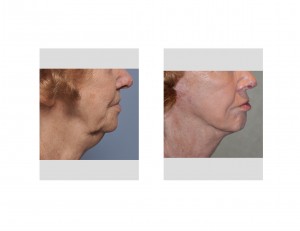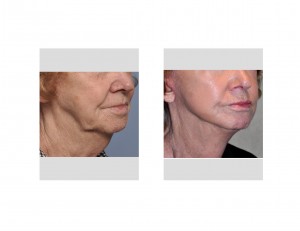Background: Aging of the face is inevitable and is always dramatically seen in the lower face and neck. Sagging of the jowls and neck occurs as the ligaments weaken and the skin stretches. While initially seen as a little bit of jowling and loose neck skin it can eventually progress to a full blown turkeyneck deformity by one’s sixth or seventh decade. No matter how one ages, however, a turkeyneck is inevitable by the eighth decade of life.
The facelift procedure, sometimes called a necklift, is the definitive answer to the jowl and neck issues of aging. While many variations of a facelift exist, in the end it requires incisions around the ears and extensive tissue undermining and tightening. The bigger the neck deformity, the more extensive the facelift has to be. One of the defining differences between fuller versions of a facelift and many of the more limited or ‘mini-‘ varieties is the length and location of the incision on the back of the ear. A longer incision that extends out from behind the ear and into the occipital hairline is needed to really change the severely sagging neck.
While a facelift is a perfectly safe procedure that is commonly performed, the vast majority of patients are in the age range today from the last 40s to the mid 60s. Older patients are becoming more common as it is more accepted today to make these changes and people are living longer and are more healthy than ever before.
Case Study: This 80 year-old female wanted to get rid of her turkeyneck and the wrinkles around her mouth. She had a very typical amount of jowl and neck sagging that one would expect who is over 80 and has never had any work done. She was particularly bothered by the jowling and wrinkles around the corner of her mouth. She was in good health and had no cardiovascular, pulmonary and metabolic diseases. She had never smoked. One of the realities of any facelift surgery is that all of the wrinkles around the corner of the mouth are not going to eliminated after surgery.

Her head dressing was removed the next day and nothing was worn thereafter. She had some swelling and bruising but looked very good just ten days after surgery. When seen again at six weeks after surgery all of her incisions were healed beautifully, undoubtably due to her very thin skin. She did express some disappointment that all of her wrinkles around her mouth were not gone but this was not to be expected.

Case Highlights:
1) The lower facelift is the best treatment for the sagging jowls and neck that comes with advanced facial aging.
2) In older patients limiting the scope of the facelift and shortening the operation is an important consideration for patient safety and a quick recovery.
3) Facelifts in octogenarians can be both safely done and achieve very effective results.
Dr. Barry Eppley
Indianapolis, Indiana


